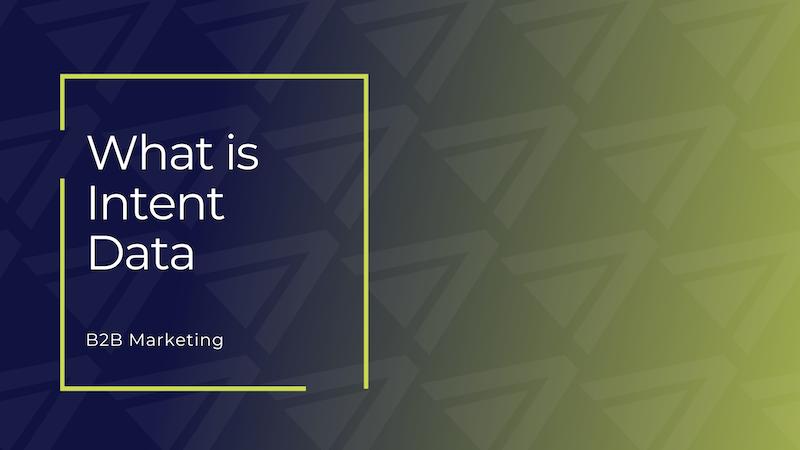Ping! Someone just downloaded your lead magnet.
You check the email and recognize the URL—it belongs to one of the top companies you’re prospecting.
“They’re interested!” you think to yourself. You alert your sales team to approach the company.
But days later, you’ve got nothing. The prospect unsubscribes from your mailing list, and you never hear from them again.
Why?
It comes down to numbers. At any one time, only 15% of your potential customers are ready to buy (source). The other 85% are downloading whitepapers, reading blogs, and consuming social media content—all with zero intention of making a purchase.
The key to succeeding in B2B marketing in 2023 is to pinpoint which companies are ready to buy—and which are not.
And the way to do that is by gathering intent data.
Keep reading to learn what intent data is, where it comes from, and how it can help you increase your closing rate.
What is Intent Data?
Intent data is information you collect on a specific account that helps you understand how ready they are to buy from you.
It’s often called the next big thing in account-based marketing, a type of marketing strategy that targets each account differently, based on their unique needs, interests, and characteristics.
Why is Intent Data Important?
Think about what you would do when you discover a problem in your business. For example, your printer’s been making a funny sound and doesn’t print color anymore.
The first thing you might do is search for the specific error message you’ve been getting to understand the problem.
You’re not ready to buy a printer yet—just trying to solve a problem.
Once you determine your printer is damaged beyond repair, you might search for lists of the best printers you can buy. You’re still not ready to buy—just gathering information.
After you identify a couple of printers you like, you might visit each company’s site to look at all the specs and decide which one to buy. Now you’re getting close to a purchase.
A printer company using intent data could discover which content you’re consuming and try to understand where you are on your journey to purchase.
They could show you ads for printer comparison articles at the same time you’re searching for them. Or they could advertise their latest printer model, so you consider it in your search.
That’s for printers, which are comparatively low cost and easy to buy.
But in the world of B2B services, marketing money becomes a lot more precious, and each sale has a tremendous impact on your bottom line.
That’s why it’s crucial for B2B service businesses to use intent data so they can understand which companies are in research mode, which are making comparisons, and which are getting ready to purchase.
Instead of wasting money and time trying to close companies that are in research mode, you can identify leads with purchase intent and focus on closing them instead.
Where Does Intent Data Come From?
Anywhere your prospect goes online can be a source of intent data.
For example, you might look at:
- The pages they visit on your website
- The posts they engage with on your social media accounts
- The reviews they read
- The blog posts they click on
- The resources they’ve downloaded
- If they’ve signed up for a trial account or not
- Their email open and click rate
- Their survey responses
- And so on
2 Types of Intent Data
Marketers gather intent data from both first-party and third-party sources.
First-party intent data comes from data you collect on platforms and accounts that you own.
This includes:
- User behavior on your website or app
- CRM data
- Mailing list subscribers and analytics
- Social media analytics
- Surveys and form data you collect
Third-party intent data comes from (you guessed it) third-party apps, advertisers, or publishers that provide the data as a service.
This includes:
- Search keywords
- Advertising data
- Other user behavior on third-party sites
What is Intent Data Used For?

Once you’ve acquired some intent data on your top leads, here are some things you can do with it:
- Score leads. Score your leads based on intent, so your sales and outreach teams can focus on the right accounts.
- Personalize outreach. Personalize outreach conversations and messages based on the content an account is consuming.
- Boost ad performance. Curate the ads an account is seeing to match their intent.
- Get more traffic. Create new pages on your website to capture traffic based on search data you collect.
- Increase content. Create new content based on current leads’ interests.
- Improve email marketing. Categorize email subscribers based on intent and send personalized email sequences to each list.
These are just a few things you can do with intent data. Once you understand more about the companies you’re targeting, you can use that knowledge to improve every facet of your marketing and sales strategy.
Is Intent Data Legal?
Intent data is legal as long as it’s captured with the user’s consent. When choosing sources of intent data, you’ll want to make sure the company complies with GDPR.
What is Bidstream Data?
Bidstream data is a type of intent data that comes from digital advertising.
Typically, online publishers will have open ad spots on each page of their website, which they offer to advertisers through an ad network.
When someone visits a page on the publisher’s website, it sends information about the page and the user to an ad network, where advertisers can “bid” on the spot.
The most relevant ad to the content and user in question will win the spot, and it’ll show up on the page—all in the few seconds it takes to load the article.
That data sent over to the ad network—which includes details like the user’s location, IP address, and the content of the page—is called bidstream data. Third-party data providers can sell this information to marketers as intent data.
However, bidstream data should be handled with caution. It’s not always collected or sold with user intent.
Make sure to carefully examine your intent data sources to understand where their information is coming from, and if it’s being collected responsibly.
Conclusion
If you’re not making use of intent data in your B2B marketing strategy, you’re leaving your sales and marketing up to chance. Are you selling to the 15% who are ready to buy? Or the 85% who aren’t?
Reach out to see how Reel Axis can help you use intent data to get better results from your B2B marketing strategy.







